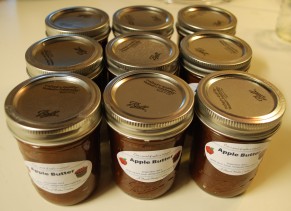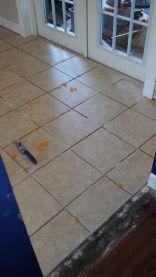A previous post explained my methodology for salsa experimentation. True to that, I have started with my most experienced version of salsa. Food processor cut, and pot cook. I upped the size to make enough for a good canning. In doing so, I think some of the quantities will have to be altered. Other than that, the results were good.
Ingredients:
- ~10lb of Roma Tomatoes
- 8 Bell Peppers (multiple colors)
- 2 Onions
- 3 Bulbs of garlic
- 1 Bunch of Cilantro
- 8 Small Habaneros
- 6 Limes
- 1/4 Cup Vinegar (evens out heat, and important acid for canning)
- 1 tbs Cumin
This worked out well and was a very tasty salsa. I might up the habaneros next time, and cut down on the bell peppers. It was a little wattery at first, and not quite enough spice. I am a lightweight on spice, so add a lot more hotness if you are a fire head.
UDPATE: Now that I have eaten a pint or two of this I think it needs fewer bell peppers. Next time I will drop down to 4-5 peppers and add a few more tomatoes. The spice starts off mild and has a slow buildup after a while.
Tomato Core and Seed
A small tomato corer or melon baller does a great job of getting the stem end out, and de-seeding. I find it is best to chop the tomato in half (top and bottom) and scooping out the seeds from there. It is quick and easy if you have the tools.
Peppers
Peppers are de-seeded by first cutting them in half, and again use a melon baller to scoop out the seeds and white material. Habaneros have most of their heat in the seeds and white center. The flesh has some spice, but also a lot of flavor. Use the baller to remove the center bits and keep the delicious flesh. Also, WEAR GLOVES! I had an interesting experience with inserting my contacts a full day after chopping habaneros with bare hands once. Not pleasant.
Food Processor
The food processor is a wonderful invention of the modern age. It does have a few issues though. First, you really don’t want to overload it. Putting too many ingredients in can cause some to become mush, and others to jump around on top un-chopped. Every food processor has its limit, so start small, and work your way up until you find yours. Never use the ON feature either, if you have a pulse button. Pulsing manually helps keep things mixed up and aids consistency.
When doing salsa, I want some ingredients to be a little coarser. Putting in only a single pepper, or 2-3 tomatoes at a time and doing a few quick pulses gives good results. Again, If I threw twice that in and tried it the results would be all across the map. I quarter the big peppers and onions before putting them in, while the tomato halves get thrown in as is. Cutting these smaller to start with, might help the processor out. I will try that in the future.
Cook Down
I cooked down the ingredients for 2-3 hours to concentrate flavor and reduce water content. We had a party to get to, so some of this got spooned off and offered fresh out of the pot. The rest was refrigerated and canned the next day. I have done this a number of times with good results. Sometimes you just don’t have a whole day to can.
Overall I am very happy with this salsa. It only took about 2 hours to make from start to finish plus the cook down and canning. The food processor and melon baller make things go quickly. The texture is fine with a few monster chunks that didn’t get through the food processor right. There was a lot of water, but this could have been from the high pepper content. I would rate it a solid salsa with an easy prep and cleanup. I think the pan searing will offer a bolder smokey flavor, and the mill might improve texture. Still, this is a good go-to recipe for salsa.
-Chase















































